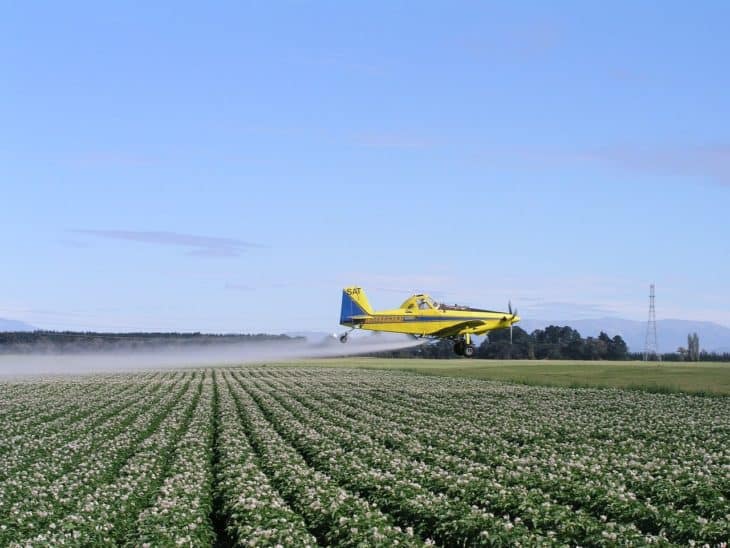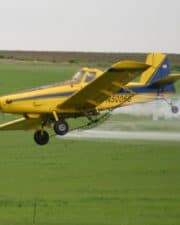The attractive woman in the Panama hat strolling through her garden heard the unmistakable sound of the Stearman – Boeing – Model 75 biplane and looked up just in time to see the open cockpit crop duster careen past. She wondered aloud, “How low are those things supposed to fly?” Good question. The only correct answer, though, is, it depends.
Table of Contents
How low do crop dusters fly?
Over congested areas crop duster planes cannot fly below 1000 feet. Over rural land, they may operate at a minimum of 500 feet. While spraying crops, pilots have to do their best to reduce drift of the chemicals, which means flying as low as possible. They can then fly down to about 8 feet above the crops.
What is A Crop Duster
The term crop duster derived in the early days from the use of dry chemicals as insecticides. The planes are not called crop dusters anymore, because what they do is not called crop dusting. Modern pilots prefer what they do being called ag application or aerial application.
Today, liquid applications are used to control pests, diseases, and to deliver nutrients to crops. For the sake of nostalgia, though, the term crop duster will be used here.

Early on, the planes used as crop dusters were surplus war planes. In 1921, U.S. Army pilot Lt. John A. Macready used a modified Curtiss JN-6 “Super Jenny” to apply lead arsenate dust on catalpa trees to eradicate sphinx moth larvae. The next year, Curtiss biplanes dusted cotton fields in Louisiana to control boll weevils.
On 1923, the forerunner of Delta Airlines, Huff-Daland Dusters, Inc., performed the first commercial dusting of crops. There are now about 1,560 crop dusting businesses in the U. S. Crop dusting, or aerial application, meets up to 25% of the demand for American agricultural crop production products.
Rules and Regulations
Typically, the average crop duster pilot has over 27 years of experience in the field. Getting the dull part out of the way, Title 14 of the Code of Federal Regulations (14 CFR) part 137 is the controlling set of regulations for crop dusting.
The National Agricultural Aviation Association, the NAAA, “provides networking, educational, government relations, public relations, recruiting and informational services to its members and the aerial application industry as a whole.” The NAAA reports there are crop dusting operations in 45 states.
Certification
Anyone operating a crop duster must be certified, unless the operator is the Federal, State or local government. To receive a certificate, an applicant must have a current U.S. private, commercial, or airline pilot certificate.
The bottom line is this: The crop dusting industry is well-regulated, including certification, operating rules, and records and reports. Such regulation is necessary because of the many risks involved.
Hazards
Operating crop dusters is dangerous work. It can be dangerous for the pilots and for people on the ground.
The National Transportation and Safety Board – NTSB – reported at the end of 2017 a total of 67 crop dusting accidents, seven of which involved a fatality. Of those seven, fire was related to four of the deaths.

The three-year period previous to 2017 averaged 11.3 fatalities per year. From 2009 to 2018, 21% of crop dusting crash fatalities resulted from collisions with towers or power lines. As a result, the NAAA is asking the Federal Aviation Association, FAA, for increased guidance on marking obstacles.
In areas like Texas cotton farming country, there are complaints of the “chemical drift” of pesticides from crop dusters killing trees, poisoning livestock and sickening people.
Pilots with the skills necessary to be crop dusters also use their flying talents to water bomb fires. Recently, three American pilots, military veterans, died flying a firebombing mission in New South Wales when their C-130 crashed.
So How Low Can a Crop Duster Fly?
Other than on take offs and landings, agricultural aircraft must fly above 1,000 feet from the surface over congested areas.
The aircraft may, however, be operated below 500 feet over “persons, vessels, vehicles, and structures,” if no hazard to people of property is created.

When flying over a congested area, a crop duster must exercise “maximum safety” consistent for the purpose of the operation, and in accordance with the following:
- written approval
- public notice
- a submitted plan for the flight
- single-engine guidelines
- multiengine guidelines
To decide what a congested area is, attention must be turned to the FAA. Again, though, we go back to the beginning of this article with “it depends” what a congested area is, because the FAA determines what a congested area is on a case-by-case basis.
It is obvious that crop dusting is a highly skilled and hazardous occupation, fraught with stereotypes of old, aviation’s version of the devil-may-care swashbuckler.
Today’s crop dusters – ag pilots – are highly trained and experienced pilots flying state-of-the art equipment delivering services who often serve as water bombers to extinguish fires like those in Australia.
Related Posts













